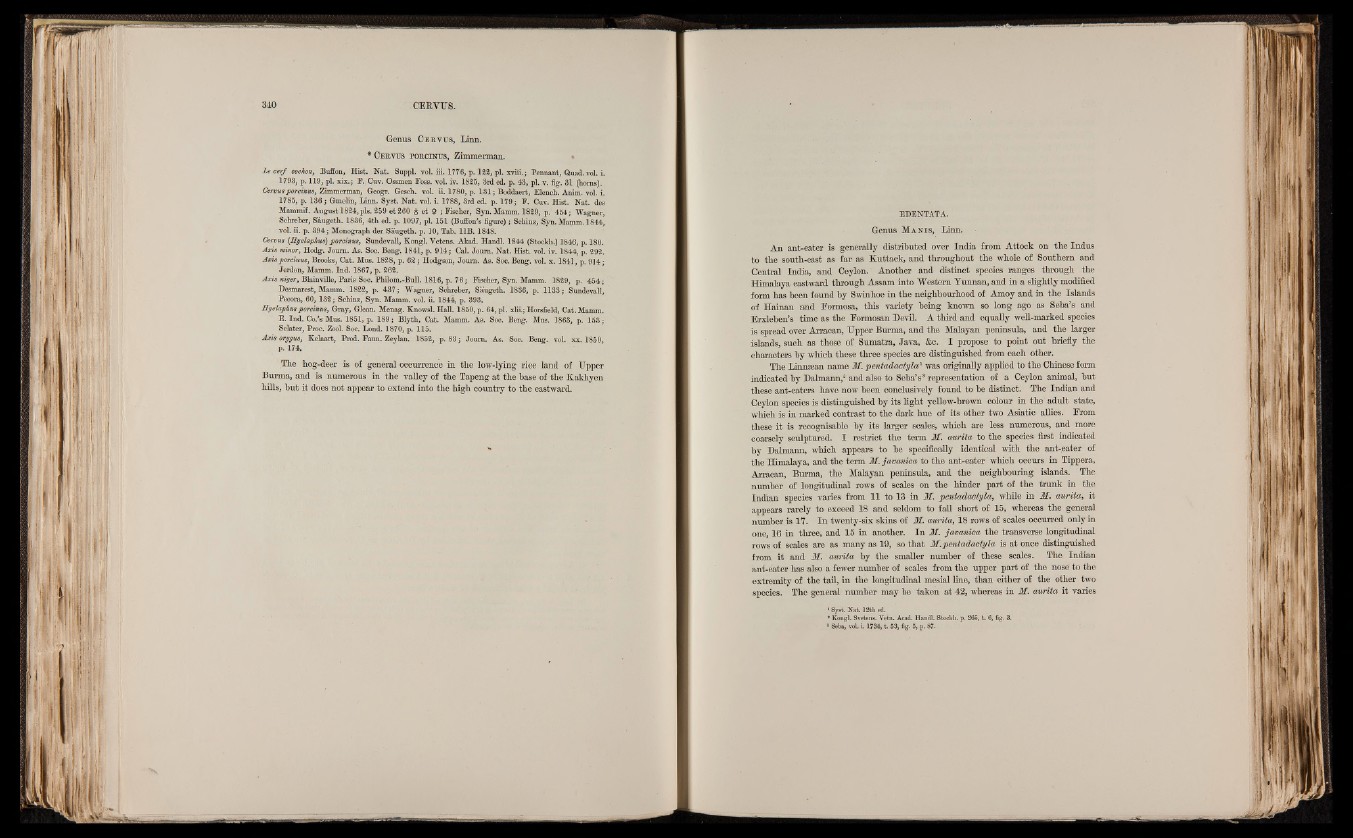
Genus Cervus, Linn.
* C er v t js p o r c in u s , Zimmerman.
Le cerf cochort, Buffon, Hist. Nat. Suppl. vol. iii. 1776, p. 122, pi. xviii.; Pennant, Quad. vol. i.
1793, p. 119, pi. xix.; P. Cuv. Ossmen Foss. vol. iv. 1825, 3rd ed. p. 43, pi. v. fig. 81 (horns).
Cervus porcinus, Zimmerman, Geogr. Gesch. vol. ii. 1780, p. 181; Boddaert, Elench. Anim. vol. i.
1785, p. 186; Gmelin, Linn. Syst. Nat. vol. i. 1788, 3rd ed. p. 179; F. Cuv. Hist. Nat. des
Mammif. August 1824, pis. 259 et260 $ e t ? ; Fischer, Syn. Mamm. 1829, p. 454; Wagner,
Schreber, Saugeth. 1886, 4th ed. p. 1097, pi. 151 (Buffon’s figure); Sehinz, Syn. Mamm. 1844,
vol. ii. .p. 894; Monograph der Saugeth. p. 10, Tab. 11B. 1848.
Cervus (Eyelaphus) porcinus, Sundevall, Kongl. Vetens. Akad. Handl. 1844 (Stockh.) 1846, p. 180.
Axis minor, Hodg. Joum. As. Soc. Beng. 1841, p. 914; Cal. Joum. Nat. Hist. vol. iv. 1844, p. 292.
Jans porcinus, Brooks, Cat. Mus. 1828, p. 6 2 ; Hodgson, Joum. As. Soc. Beng. vol. x. 1841, p. 914;
Jerdon, Mamm. Ind. 1867, p. 262.
Axis niger, Blainville, Paris Soc. Philom.-Bull. 1816, p. 76; Fischer, Syn. Mamm. 1829, p. 454;
Desmarest, Mamm. 1822, p. 487; Wagner, Schreber, Saugeth. 1886, p. 1188; Sundevall,
Pecora,.60, 182; Schinz, Syn. Mamm. vol. ii. 1844, p. 898.
Hyelaphus porcinus, Gray, Glean. Menag. Knowsl. Hall. 1850, p. 64, pi. xlii.; Horsfield, Cat. Mamm
E. Ind. Co.’s Mus. 1851, p. 189; Blyth, Cat. Mamm . As. Soc. Beng. Mus. 1868, p. 158;
Sdater, Proc. Zool. Soc. Lond. 1870, p. 115.
Axis orygus, Kelaart, Prod. Faun. Zeylan. 1852, p. 88; Joum. As. Soc. Beng. vol. xx. 1850>
p. 174.
The hog-deer is of general occurrence in the low-lying rice land of Upper
Burma, and is numerous in the valley of the Tapeng at the base of the Kakhyen
hills, hut it does not appear to extend into the high country to the eastward.
EDENTATA.
Genus M a n i s , Linn.
An ant-eater is generally distributed over India from Attock on the Indus
to the south-east as far as Kuttack, and throughout the whole of Southern and
Central India, and Ceylon. Another and distinct species ranges through the
Himalaya eastward through Assam into Western Yunnan, and in a slightly modified
form has been found by Swinhoe in the neighbourhood of Amoy and in the Islands
of TTfliimn and Formosa, this variety being known so long ago as Seba’s and
Erxleben’s time as the Formosan Devil. A third and equally well-marked species
is spread over Arraean, Upper Burma, and the Malayan peninsula, and the larger
islands, such as those of, Sumatra, Java, &c. I propose to point out briefly the
characters by which these three species are distinguished from each other.
The Linnflp-an name M. pentadactyla1 was originally applied to the Chinese form
indicated by Dalmann,* and also to Seba’s3 representation of a Ceylon animal, but
these ant-eaters have now been conclusively found to be distinct. The Indian and
Ceylon species is distinguished by its light yellow-brown colour in the adult state,
which is in marked contrast to the dark hue of its other two Asiatic allies. From
these it is recognisable by its larger scales, which are less numerous, and more
coarsely sculptured. I restrict the term M. a/u/rita to the species first indicated
by Dalmann, which appears to be specifically identical with the ant-eater of
the Himalaya, and the term M. javamca to the ant-eater which occurs in Tippera,
Arraean, Burma, the Malayan peninsula, and the neighbouring islands. The
number of longitudinal rows of scales on the hinder part of the trunk in the
Indian species varies from 11 to 13 in M. pentadactyla, while in M. aurita, it
appears rarely to exceed 18 and seldom to fall short of 15, whereas the general
number is 17. In twenty-six skins of M. aurita, 18 rows of scales occurred only in
one, 16 in three, and 15 in another. In M. javcmica the transverse longitudinal
rows of scales are as many as 19, so that M. pentadactyla is at once distinguished
from it and M. av/rita by the smaller number of these scales. The Indian
ant-eater has also a fewer number of scales from the upper part of the nose to the
extremity of the tail, in the longitudinal mesial line, than either of the other two
species. The general number may be taken at 42, whereas in M. aurita it varies
1 Syst. Nat. 12th ed.
* Kongl. Svetens. Vetn. Acad. Handl. Stockh. p. 265, t. 6, fig. 3.
8 Seba, vol. i. 1734, t. 53, fig. 5, p. 87.